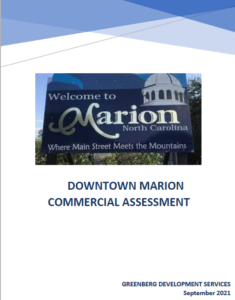 As most of the country’s tourism markets were taking a big hit from the pandemic, some communities in western North Carolina saw glimmers of opportunity: between the allure of the great outdoors, the blossoming of remote work options, and their own authentic small-town charms, they experienced a distinct up-tick in interest and housing prices as visitors found their way along the scenic mountain parkways. Many of those visitors want to stay and the demand isn’t going away. That’s why, in 2021, three communities in three different counties explored how they might capitalize on their existing assets to drive sustainable residential and commercial growth. Smart Growth grants from the REALTOR® Party helped with the process.
As most of the country’s tourism markets were taking a big hit from the pandemic, some communities in western North Carolina saw glimmers of opportunity: between the allure of the great outdoors, the blossoming of remote work options, and their own authentic small-town charms, they experienced a distinct up-tick in interest and housing prices as visitors found their way along the scenic mountain parkways. Many of those visitors want to stay and the demand isn’t going away. That’s why, in 2021, three communities in three different counties explored how they might capitalize on their existing assets to drive sustainable residential and commercial growth. Smart Growth grants from the REALTOR® Party helped with the process.
Michael Cooper, a Regional Government Affairs Director with the North Carolina Association of REALTORS®, explains the renewed interest in rural parts of North Carolina as a destination and a place to live, work, and raise a family. “With more Americans working from home that really puts us on the map because of our scenery and our quality of life. For places like these,” he says, “it’s turned out to be a great time to support new housing and to grow the local economy.”
He began researching the potential of the REALTOR® Party’s Smart Growth Grants to ignite community revitalization after learning about them at a virtual NAR conference. He encouraged three communities in his region to pursue Mainstreet Development Assessments based on North Carolina’s Main Street program, ultimately helping to secure Smart Growth Grants on behalf of the Yancey-Mitchell Board of REALTORS® for the town of Spruce Pine; the McDowell Board of REALTORS® for the city of Marion; and the High County Association of REALTORS® for the town of Newland.
The assessments were conducted by Hilary Greenberg, a respected planning and economic development consultant from Charlotte, North Carolina, who travelled to the communities and working closely with local host organizations: the Marion Business Association, the Spruce Pine Main Street Organization, and the Avery County Economic Development Committee. She met with community leaders and interviewed stakeholders, went on walking tours and visited businesses. For each town, she developed extensive reports based on her observations of each area’s strengths, weaknesses, opportunities, and threats, and provided clear recommendations to improve and sustain the communities’ economic vitality.
“Each of the communities now has a wonderful document that’ll be a roadmap for thoughtful development,” says Cooper. “It’s up to them to decide how to move forward and allocate their assets, but they can do so with a high level of confidence in these reports.” REALTOR® members who participated at the information-gathering meetings are excited about the prospects, he adds, noting that it has been a great way for them to be involved locally. “REALTORS® know their towns better than anyone,” he says, “they care about the schools, the parks, the downtown, the local economy, and through NAR they can utilize these grants to help make their communities the best that they can be.”
Next steps for the local associations are likely to include applying for Placemaking Grants from the REALTOR® Party, says Cooper. “We’re so lucky to have these resources available at the national level. In a small and rural places these grants have real bang for the buck, both in getting the work done and in demonstrating the clout and commitment of the REALTORS®.”
To learn more about how North Carolina REALTORS® is helping its local associations revitalize small communities with roadmaps for creating more vibrant downtowns, contact Regional GAD Michael Cooper at mcooper@ncrealtors.org or 336.927.2158.

Post a comment